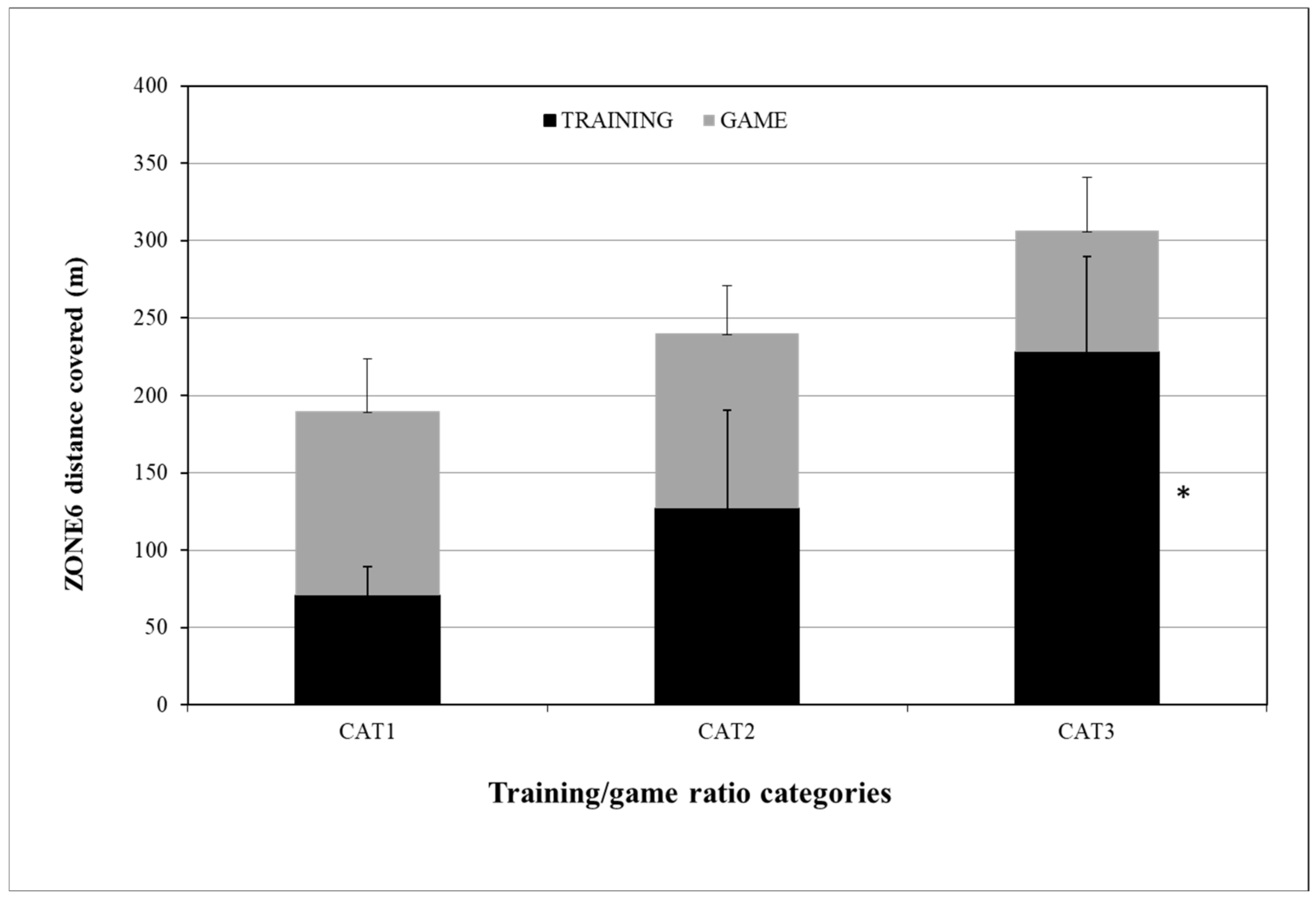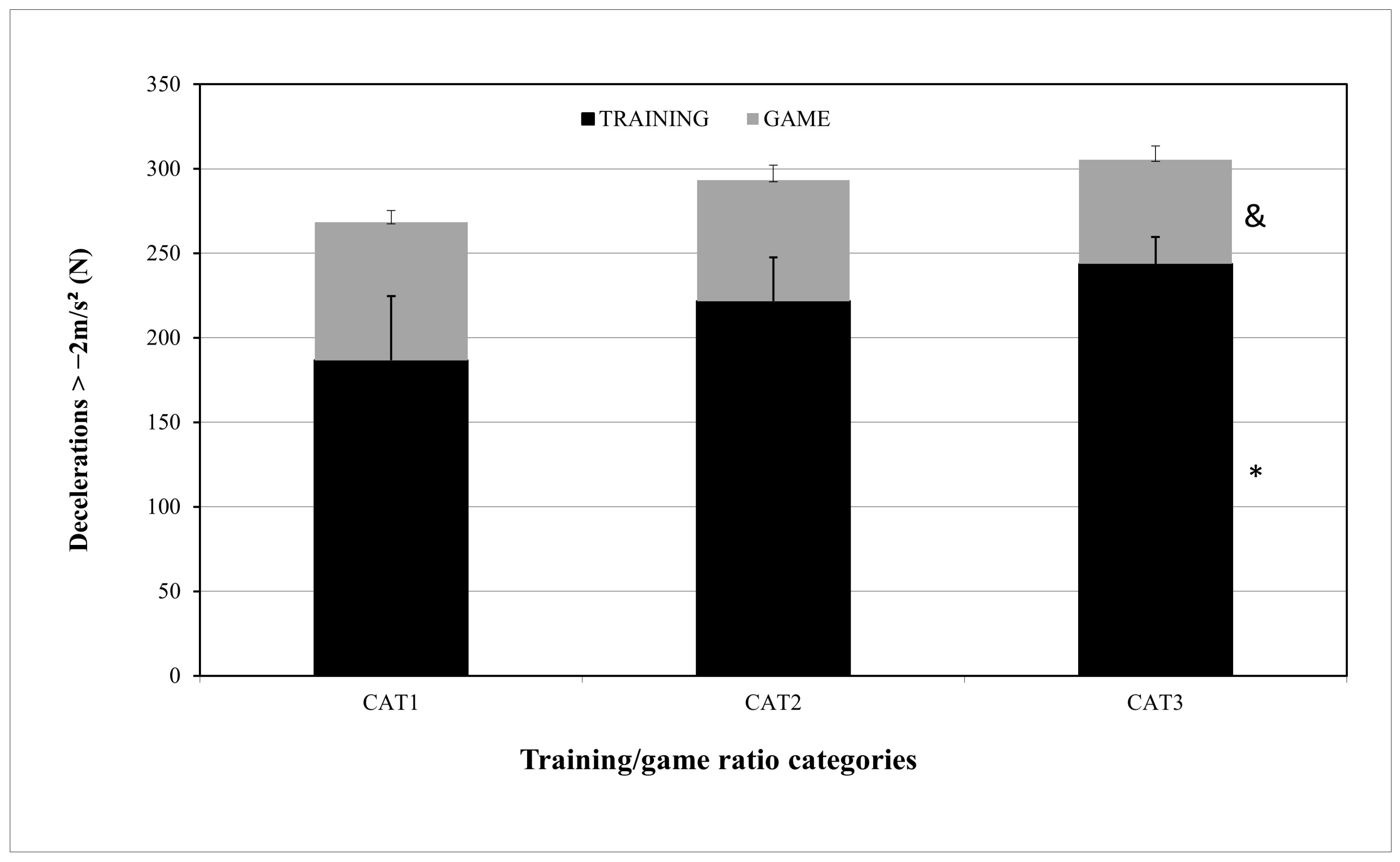Weekly External Load Correlation in Season Microcycles with Game Running Performance and Training Quantification in Elite Young Soccer Players
Abstract
:1. Introduction
2. Materials and Methods
2.1. Study Design
2.2. Subjects
2.3. Training Content
2.4. Data Collection
2.5. Hypotheses and Statistical Analysis
3. Results
3.1. Correlation between Weekly Training Load and Game Performance
3.2. Differences between Training/Game Ratios
4. Discussion
5. Conclusions
6. Practical Applications
Author Contributions
Funding
Institutional Review Board Statement
Informed Consent Statement
Data Availability Statement
Acknowledgments
Conflicts of Interest
References
- Cummins, C.; Rhonda, O.; O’Connor, H.; West, C. Global Positioning Systems (GPS) and microtechnology sensors in team sports: A systematic review. Sports Med. 2013, 43, 1025–1042. [Google Scholar] [CrossRef] [PubMed]
- Impellizzeri, F.M.; Marcora, S.M.; Coutts, A.J. Internal and External training load: 15 years on. Int. J. Sports Physiol. Perform. 2019, 14, 270–273. [Google Scholar] [CrossRef] [PubMed]
- Jaspers, A.; Brink, M.S.; Probst, S.G.; Frencken, W.G.P.; Helsen, W.F. Relationships between training load indicators and training outcomes in professional soccer. Sports Med. 2017, 47, 533–544. [Google Scholar] [CrossRef]
- Jaspers, A.; Kuyvenhoven, J.P.; Staes, F.; Frencken, W.G.P.; Helsen, W.F.; Brink, M.S. Examination of external and internal load indicators’ association with overuse injuries in professional soccer players. J. Sci. Med. Sport 2018, 21, 579–585. [Google Scholar] [CrossRef]
- Nikolaidis, P.T.; Clemente, F.M.; Van der Linden, C.M.I.; Rosemann, T.; Knechtle, B. Validity and reliability of 10-Hz Global Positioning System to assess in-line movement and change of direction. Front. Physiol. 2018, 9, 228. [Google Scholar] [CrossRef] [PubMed]
- Akenhead, R.; Harley, J.A.; Tweddle, S.P. Examining the external training load of an English Premier League football team with special reference to acceleration. J. Strength Cond. Res. 2016, 30, 2424–2432. [Google Scholar] [CrossRef] [PubMed]
- Malone, J.J.; Di Michele, R.; Morgans, R.; Burgess, D.; Morton, J.P.; Drust, B. Seasonal training-load quantification in elite Premier League soccer players. Int. J. Sports Physiol. Perform. 2015, 10, 489–497. [Google Scholar] [CrossRef] [PubMed]
- Vardakis, L.; Michailidis, Y.; Topalidis, P.; Zelenitsas, C.; Mandroukas, A.; Gissis, I.; Christoulas, K.; Mavrommatis, G.; Metaxas, T. Application of a structured training plan on different-length microcycles in soccer—Internal and external load analysis between training weeks and games. Appl. Sci. 2023, 13, 6935. [Google Scholar] [CrossRef]
- Varley, M.C.; Jaspers, A.; Helsen, W.F.; Malone, J.J. Methodological considerations when quantifying high-intensity efforts in team sport using Global Positioning System technology. Int. J. Sports Physiol. Perform. 2017, 12, 1059–1068. [Google Scholar] [CrossRef]
- Borresen, J.; Lampert, M.I. The quantification of training load, the training response and the effect on performance. Sports Med. 2009, 39, 779–795. [Google Scholar] [CrossRef]
- Stevens, T.G.A.; de Ruiter, C.J.; Twisk, J.W.R.; Savelsbergh, G.J.P.; Beek, J.P. Quantification of in-season training load relative to match load in professional Dutch Eredivisie football players. Sci. Med. Football 2017, 1, 117–125. [Google Scholar] [CrossRef]
- Anderson, L.; Orme, P.; Di Michele, R.; Close, G.L.; Morgans, R.; Drust, B.; Morton, J.P. Quantification of training load during one-, two- and three-game week schedules in professional soccer players from the English Premier League: Implications for carbohydrate periodization. J. Sports Sci. 2015, 34, 1250–1259. [Google Scholar] [CrossRef] [PubMed]
- Kelly, D.M.; Strudwick, A.J.; Atkinson, G.; Drust, B.; Gregson, W. Quantification of training and match-load distribution across a season in elite English Premier League soccer players. Sci. Med. Footb. 2020, 4, 59–67. [Google Scholar] [CrossRef]
- Martin-Garcia, A.; Gomez Diaz, A.; Bradley, S.P.; Morera, F.; Casamichana, D. Quantification of a professional football team’s external load using a microcycle structure. J. Strength Cond. Res. 2018, 32, 3511–3518. [Google Scholar] [CrossRef] [PubMed]
- Oliveira, R.; Brito, J.P.; Martins, A.; Mendes, B.; Marinho, D.A.; Ferraz, R.; Marques, M.C. In-season internal and external training load quantification of an elite European soccer team. PLoS ONE 2019, 14, e0209393. [Google Scholar] [CrossRef] [PubMed]
- Clemente, F.M.; Owen, A.; Serra-Olivares, J.; Nikolaidis, P.T.; Van der Linden, C.M.I.; Mendes, B. Characterization of the weekly external load profile of professional soccer teams from Portugal and Netherlands. J. Hum. Kinet. 2019, 66, 155–164. [Google Scholar] [CrossRef] [PubMed]
- Clemente, F.M.; Rabbani, A.; Conte, D.; Castillo, D.; Afonso, J.; Truman Clark, C.C.; Nikolaidis, P.T.; Rosemann, T.; Knechtle, B. Training/match external load ratios in professional soccer players: A full season study. Int. J. Environ. Res. Public Health 2019, 16, 3057. [Google Scholar] [CrossRef] [PubMed]
- Modric, T.; Versic, S.; Sekulic, D. Relations of the weekly training load indicators and running performances in professional soccer matches. Sport Mont 2021, 19, 3–9. [Google Scholar]
- Chena, M.; Morcillo, J.A.; Rodriguez-Hernandez, M.L.; Zapardiel, J.C.; Owen, A.; Lozano, D. The effect of weekly training load across a competitive microcycle on contextual variables in professional soccer. Int. J. Environ. Res. Public Health 2021, 18, 5091. [Google Scholar] [CrossRef] [PubMed]
- Palucci-Viera, L.H.; Carling, C.; Barbieri, F.A.; Aquino, R.; Santiago, P.R.P. Match running performance in young soccer players: A systematic review. Sports Med. 2019, 49, 289–318. [Google Scholar] [CrossRef]
- Coutinho, D.; Goncalves, B.; Figueira, B.; Abade, E.; Marcelino, R.; Sampaio, J. Typical weekly workload of under 15, under 17, and under 19 elite Portuguese football players. J. Sports Sci. 2015, 33, 1229–1237. [Google Scholar] [CrossRef] [PubMed]
- Mendez-Villanueva, A.; Buchheit, M.; Simpson, B.; Bourdon, P.C. Match play intensity distribution in youth soccer. Int. J. Sports Med. 2013, 34, 101–110. [Google Scholar] [CrossRef] [PubMed]
- Rave, G.; Granacher, U.; Boullosa, D.; Hackney, C.A.; Zouhal, H. How to use Global Positioning Systems (GPS) data to monitor training load in the ‘’Real World’’ of elite soccer. Front. Physiol. 2020, 11, 944. [Google Scholar] [CrossRef] [PubMed]
- Beato, M.; Coratella, G.; Stiff, A.; Iacono, A.D. The validity and between-unit variability of GNSS units (STATSports Apex 10 and 18 HZ) for measuring distance and peak speed in team sports. Front. Physiol. 2024, 9, 1288. [Google Scholar] [CrossRef] [PubMed]
- Meghanathan, N. Assortativity analysis of Real-World network graphs based on centrality metrics. Comput. Inf. Sci. 2016, 9, 3. [Google Scholar] [CrossRef]
- De Dios-Alvarez, V.; Alkain, R.; Castellano, J.; Rey, E. Accumulative weekly external and internal load relative to match load in elite male youth soccer players. Human Kinet. 2021, 34, 119–124. [Google Scholar] [CrossRef] [PubMed]





| Training/Game Ratio Category | TD | HSRD | ZONE6 Distance | ACC +2 m/s2 | DEC −2 m/s2 |
|---|---|---|---|---|---|
| CAT1 | 1.86 | 1.05 | 0.59 | 2.42 | 2.28 |
| CAT2 | 2.51 | 1.43 | 1.13 | 3.29 | 3.11 |
| CAT3 | 2.93 | 2.60 | 2.91 | 4.45 | 3.94 |
| Age | Height | Weight | Fat Mass % | |
|---|---|---|---|---|
| N | 20 | 20 | 20 | 20 |
| Missing | 0 | 0 | 0 | 0 |
| Mean | 16.4 | 171 | 62.2 | 8.47 |
| Median | 16.4 | 171 | 61.4 | 8.50 |
| Standard deviation | 0.3 | 3.0 | 3.7 | 0.6 |
| Minimum | 16.0 | 165 | 57.0 | 7.40 |
| Maximum | 16.9 | 176 | 69.1 | 9.40 |
| GD+1 | GD+2 | GD-4 | GD-3 | GD-2 | GD-1 |
|---|---|---|---|---|---|
| Day Off | Dynamic warm-up 10′ | Dynamic warm-up 10′ | Dynamic warm-up 10′ | Dynamic warm-up 10′ | Dynamic warm-up 10′ |
| Resistance training targeting hypertrophy or max strength 30′ | Possession game 8 vs. 8–10 vs. 10 12′ | Possession game 4 vs. 4 + 3 joker in reduced space 25 × 18 m 12′ | Passing drills 12′ | Coordination, acceleration, reaction 10′ | |
| Tactical game 10 vs. 10 + 2 GK in reduced space 60 × 50 m 15′ | Tactical content: game in large space 94 × 60 m targeting transition 20′ | Tactical content: game 9 vs. 9 in reduced space 55 × 45 m targeting pressing 15′ | Tactical content 20′ | Tactical content 20′ | |
| Large-sided game: 10 vs. 10 + 2 GK 15′ | Small-sided games: 3 vs. 3–5 vs. 5 + 2 GK 12′–15′ | Game 10 vs. 10 + 2 GK in reduced space 60 × 50 m 12′ | Game 10 vs. 10 + 2 GK in reduced space 70 × 50 m 10′ | ||
| Set pieces offensive/defensive 15′ |
| df | Total Distance | HSR Distance | ZONE6 Distance | ACC > +2 m/s2 | DEC > −2 m/s2 | |
|---|---|---|---|---|---|---|
| MIC1 | 26 | 0.788 *** | 0.701 *** | 0.572 *** | 0.249 | 0.949 *** |
| MIC2 | 30 | 0.756 *** | 0.278 | 0.270 | 0.472 ** | 0.460 ** |
| MIC3 | 17 | 0.858 *** | 0.892 *** | 0.547 * | 0.601 ** | 0.569 * |
| MIC4 | 27 | 0.880 *** | 0.781 *** | 0.481 ** | 0.432 * | 0.449 * |
| MIC5 | 25 | 0.880 *** | 0.781 *** | 0.455 * | 0.432 * | 0.449 * |
| MIC6 | 27 | 0.800 *** | 0.393 * | 0.383 * | 0.357 | 0.347 |
| MIC7 | 30 | 0.740 *** | 0.270 | 0.096 | 0.397 * | 0.637 *** |
| MIC8 | 30 | 0.848 *** | 0.512 ** | 0.258 | 0.190 | 0.382 * |
| MIC9 | 28 | 0.821 *** | 0.814 *** | 0.563 *** | 0.638 *** | 0.684 *** |
| MIC10 | 22 | 0.871 *** | 0.705 *** | 0.542 ** | 0.457 * | 0.478 * |
| MIC11 | 22 | 0.924 *** | 0.812 *** | 0.659 *** | 0.675 *** | 0.768 *** |
| MIC12 | 32 | 0.706 *** | 0.805 *** | 0.601 *** | 0.270 | 0.387 * |
| MIC13 | 45 | 0.823 *** | 0.815 *** | 0.596 *** | 0.362 * | 0.461 ** |
| MIC14 | 30 | 0.701 *** | 0.634 *** | 0.587 *** | 0.467 ** | 0.486 ** |
| MIC15 | 30 | 0.894 *** | 0.847 *** | 0.564 *** | 0.464 ** | 0.490 ** |
| MIC16 | 40 | 0.796 *** | 0.608 *** | 0.275 | 0.274 | 0.576 *** |
| MIC17 | 32 | 0.836 *** | 0.815 *** | 0.492 ** | −0.059 | 0.086 |
| MIC18 | 33 | 0.905 *** | 0.749 *** | 0.682 *** | 0.573 *** | 0.698 *** |
Disclaimer/Publisher’s Note: The statements, opinions and data contained in all publications are solely those of the individual author(s) and contributor(s) and not of MDPI and/or the editor(s). MDPI and/or the editor(s) disclaim responsibility for any injury to people or property resulting from any ideas, methods, instructions or products referred to in the content. |
© 2024 by the authors. Licensee MDPI, Basel, Switzerland. This article is an open access article distributed under the terms and conditions of the Creative Commons Attribution (CC BY) license (https://creativecommons.org/licenses/by/4.0/).
Share and Cite
Kanaras, V.; Michailidis, Y.; Mandroukas, A.; Stafylidis, A.; Vardakis, L.; Kyranoudis, A.E.; Christoulas, K.; Gissis, I.; Metaxas, T.I. Weekly External Load Correlation in Season Microcycles with Game Running Performance and Training Quantification in Elite Young Soccer Players. Sensors 2024, 24, 4523. https://doi.org/10.3390/s24144523
Kanaras V, Michailidis Y, Mandroukas A, Stafylidis A, Vardakis L, Kyranoudis AE, Christoulas K, Gissis I, Metaxas TI. Weekly External Load Correlation in Season Microcycles with Game Running Performance and Training Quantification in Elite Young Soccer Players. Sensors. 2024; 24(14):4523. https://doi.org/10.3390/s24144523
Chicago/Turabian StyleKanaras, Vasileios, Yiannis Michailidis, Athanasios Mandroukas, Andreas Stafylidis, Lazaros Vardakis, Angelos E. Kyranoudis, Kosmas Christoulas, Ioannis Gissis, and Thomas I. Metaxas. 2024. "Weekly External Load Correlation in Season Microcycles with Game Running Performance and Training Quantification in Elite Young Soccer Players" Sensors 24, no. 14: 4523. https://doi.org/10.3390/s24144523







